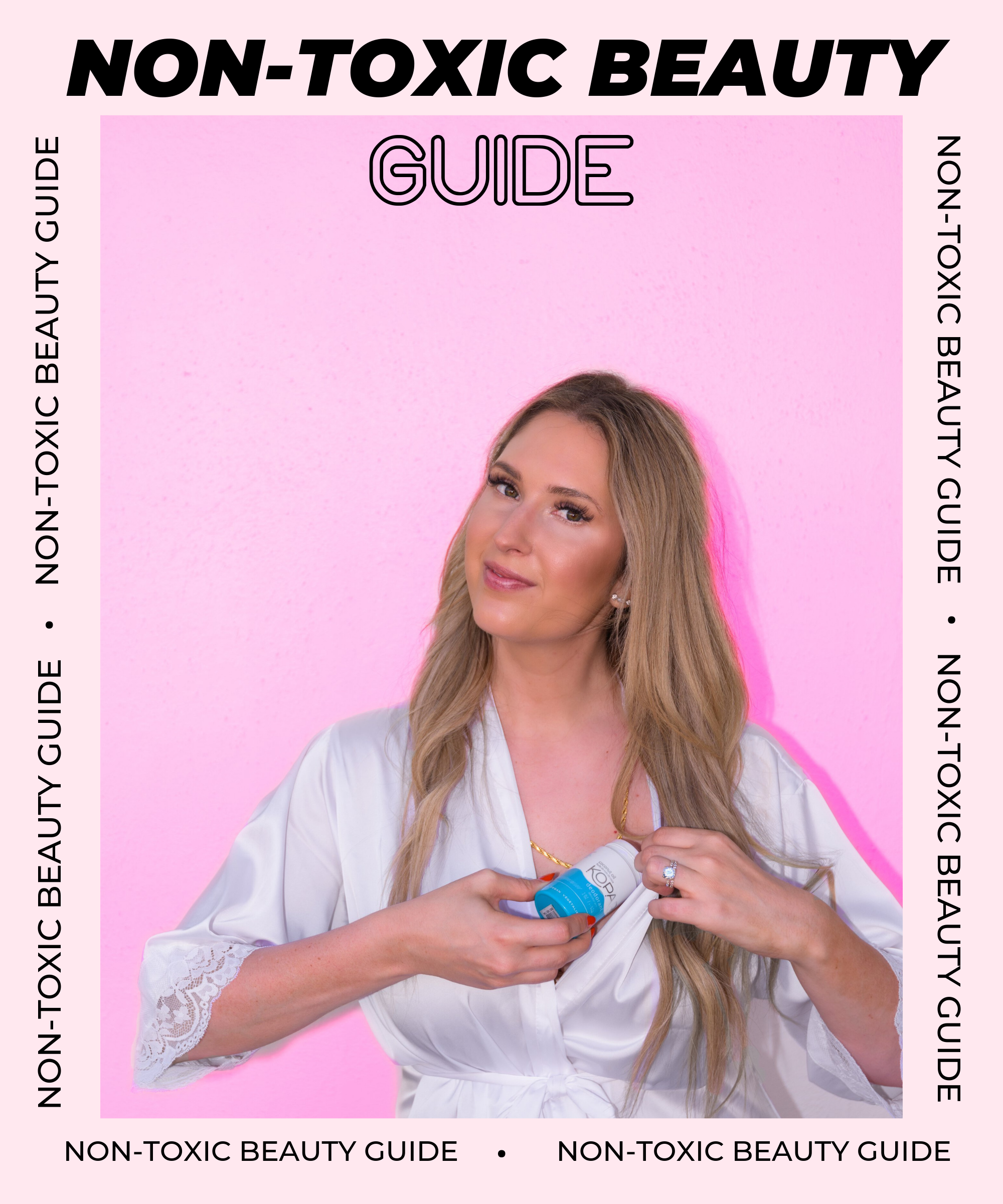
I’m embarrassed to blog about beauty and not be super knowledgeable about non-toxic beauty. Yikes! It is something that I care about and try to pay attention to when I shop for all products, actually, but there is a difference between non-toxic and cruelty free, for example.
I’m proud to say that all of the beauty products I currently use and shop for are cruelty free, meaning that no animals were tested on during the manufacturing process.
But non-toxic beauty is another ballgame. And I’ve been on auto-pilot when it comes to buying beauty products because it’s what’s mainstream, unfortunately. Looking at ingredients when buying food is one thing, but beauty products? I rarely did this until very recently.
I knew that some of the items in my stash were potentially hazardous…and to put things into perspective, the E.U. has banned around 1400 ingredients from personal care products, and the U.S. has banned a measly 30). The logic of combining NARS Blush (which I have not repurchased since they started testing on animals) with my non-toxic foundation just didn’t make sense.
I am now slowly but surely adding in staple beauty products to replace the toxic ones.
Before we get into my favorite non-toxic beauty staples, here are the 10 most commonly used ingredients to avoid:
Parabens: Parabens are widely used preservatives that prevent the growth of bacteria, mold and yeast in cosmetic products. Sounds good, right? Not so fast, they do more than that. Parabens possess estrogen-mimicking properties that are associated with increased risk of breast cancer. These chemicals are absorbed through the skin and have been identified in biopsy samples from breast tumors. They can be found in makeup, body washes, deodorants, shampoos and facial cleansers. You can also find them in food and pharmaceutical products. {Source}
Synthetic colors. If you take a look at your product label and notice FD&C or D&C, they represent artificial colors. F — representing food and D&C representing drug and cosmetics. These letters precede a color and number (e.g., D&C Red 27 or FD&C blue 1). These synthetic colors are derived from petroleum or coal tar sources. Synthetic colors are suspected to be a human carcinogen, a skin irritant and are linked to ADHD in children. The European Classification and Labeling considers it a human carcinogen and the European Union has banned it. {Source}
Fragrance. This particular category is pretty scary, because what does “fragrance” mean anyway? This term was created to protect a company’s “secret formula.” But as the consumer you could be putting on a concoction that contains tons of chemicals that are hazardous to your health. Fragrance mixes have been associated with allergies, dermatitis, respiratory distress and potential effects on the reproductive system. It can be found in many products such as perfume, cologne, conditioner, shampoo, body wash and moisturizers. {Source}
Phthalates. A group of chemicals used in hundreds of products to increase the flexibility and softness of plastics. The main phthalates in cosmetics and personal care products are dibutyl phthalate in nail polish, diethyl phthalate in perfumes and lotions, and dimethyl phthalate in hair spray. They are known to be endocrine disruptors and have been linked to increased risk of breast cancer, early breast development in girls, and reproductive birth defects in males and females. Unfortunately, it is not disclosed on every product as it’s added to fragrances (remember the “secret formula” not listed), a major loophole in the law. They can be found in deodorants, perfumes/colognes, hair sprays and moisturizers. {Source}
Triclosan. Tricolson is widely used antimicrobial chemical that’s a known endocrine disruptor — especially thyroid and reproductive hormones, and a skin irritant. Studies raise concerns that triclosan contributes to making bacteria antibiotic-resistant. There also wasn’t enough supporting evidence that washing with antibacterial soaps containing triclosan provides any benefit over washing with regular soap and water. Tricolson can be found in toothpastes, antibacterial soaps and deodorants. {Source}
Sodium lauryl sulfate (SLS) / Sodium laureth sulfate (SLES). This surfactant can be found in more than 90 percent of personal care and cleaning products (think foaming products). SLS’s are known to be skin, lung, and eye irritants. A major concern about SLS is its potential to interact and combine with other chemicals to form nitrosamines, a carcinogen. These combinations can lead to a host of other issues like kidney and respiratory damage. They can be found in shampoo, body wash/cleanser, mascara and acne treatment. {Source}
Formaldehyde. Formaldehyde and formaldehyde-releasing preservatives (FRP’s) preservatives are used in many cosmetic products to help prevent bacteria growth. This chemical was deemed as a human carcinogen by The International Agency for Research on Carcinogens (IARC) and has been linked to occupational related cancers: nasal and nasopharyngeal. It is known to cause allergic skin reactions and it may also be harmful to the immune system. It can be found in nail polish, body washes, conditioners, shampoos, cleansers, eye shadows, nail polish treatments. {Source}
Toluene. A petrochemical derived from petroleum or coal tar sources. You may see it on labels listed as benzene, toluol, phenylmethane, methylbenzene. Toluene is a potent solvent able to dissolve paint and paint thinner. It can affect your respiratory system, cause nausea and irritate your skin. Expecting mothers should avoid exposure to toluene vapors as it may cause developmental damage in the fetus. Toluene has also been linked to immune system toxicity. It can be found in nail polish, nail treatments and hair color/bleaching products. {Source}
Propylene glycol. Propylene glycol is a small organic alcohol commonly used as a skin-conditioning agent. It’s classified as a skin irritant and penetrator. It has been associated with causing dermatitis as well as hives in humans — these sensitization effects can be manifested at propylene glycol concentrations as low as 2 percent. It can be found in moisturizers, sunscreen, makeup products, conditioners, shampoo and hair sprays. {Source}
Sunscreen chemicals. These chemicals function as a sunscreen agent, to absorb ultraviolet light. These chemicals are endocrine disruptors and are believed to be easily absorbed into the body. They may also cause cellular damage and cancer in the body. Common names are benzophenone, PABA, avobenzone, homosalate and ethoxycinnmate. They can be found in sunscreen products. {Source}
SCARY SHIT, RIGHT?!

♡ FACIAL OIL
ACURE MARULA OIL
If I had to choose one oil and only one to use on my face everyday, morning and night, I’d choose Marula oil. Acure’s Marula oil is rich in proteins and omega fatty acids and is amazing for treating dry skin, healing wounds & scars and reducing redness. “Marula oil packs a huge anti-oxidant power punch to help with anti-aging along with essential fatty acids and proteins to help with firming, anti-inflammatory and anti-swelling support.” Marula is naturally lightweight, meaning it will absorb readily into the skin, leaving it feeling hydrated and smooth. What’s also cool? Acure’s Marula oil is 100% pure and wildcrafted without pesticides by South African Women as part of an economic empowerment program. I buy mine at Whole Foods (BTW – the Whole Foods Beauty department is pretty amazing if you haven’t checked it out).
♡ BODY EXFOLIATOR
HERBIVORE BOTANICALS COCO ROSE BODY POLISH
Herbivore products are ALL truly natural, vegan, and cruelty-free. They contain no synthetic ingredients— this includes no dyes, no fragrances, and no synthetic preservatives. Additionally, they are concentrated blends containing no fillers and using the minimum amount of ingredients necessary to achieve the maximum results. My Holy Grail Herbivore product is the Body Polish. It smells SO good (no fragrances used, BTW, just Moroccan Roses) and it does the job well to exfoliate the body. I have KP (Keratosis Pilaris) on my arms, and I love how well the Body Polish helps maintain smoothness.
A HUGE plus is that the packaging is so Instagrammy and pretty! If you’re stumped on a gift for a friend, you can’t go wrong with this stuff.
♡ DEODERANT
KOPARI COCONUT DEO
First, do you know the difference between deodorant and antiperspirants? If you check your product, you might be wearing an antiperspirant – which is not good. The difference is, antiperspirants are built to clog and block your sweat glands/pores, and to essentially keep the toxins of your body in…the ones that make you smell like B.O. Antiperspirants are also usually made with aluminum – more not so great news. Not only are the toxins in your body getting stuck (they’re trying to release themselves via sweat, but we don’t let them), but aluminum has been linked to scary AF things like breast cancer and can even accumulate in your brain! UM… WHAT?! Deodorants on the other hand, work to neutralize the smell, but actually still allow the toxins in your system (aka sweat) to release. Which is why you will still sweat wearing natural deodorants. I’d rather sweat than deal with all of the scary shit.
Enter Kopari’s Coconut Deo. It is my favorite non-toxic deodorant, and this is saying A LOT because I have been testing non-toxic deodarants out for about 10 years (the first place I went non-toxic)…and they pretty much all suck. Not this one, though. It is 100% plant derived and non-toxic. Like the name suggests, it’s a coconut-powered product, and the whole line is actually made from coconut. The biggest bonus is that is smells like you’re on a vacay in Hawaii 24/7.
♡ SUNSCREEN
ELTA MD SUNSCREEN
We know sunscreen’s purpose is to help prevent skin cancer, but paradoxically chemical sunscreens use ingredients with links to cancer.
The easiest way to differentiate between which sunscreens are ‘good’ and which are ‘bad’ is to know the two different types: chemical (BAD) because it penetrates your skin to filter and absorb UV rays. And physical, also known as mineral, which is a physical barrier between your skin and the sun.
Oxybenzone is one of the ingredients used in some chemical sunscreens that causes issues. In 2012, California listed benzophenone as a known carcinogen. Guess what oxybenzone’s other name is? Benzophenone-3. Yes, the ingredient in many sunscreens is a derivative of a carcinogen. That doesn’t necessarily mean oxybenzone is a carcinogen, but it’s close enough to stay the hell away.
Mineral sunscreens are usually formulated with zinc oxide which white in color. But that’s not the case with Elta MD’s Facial SPF. It absorbs right away and is free of parabens, chemicals, fragrance, and the notorious oxybenzone.
♡ FOUNDATION
LAWLESS WOKE UP LIKE THIS FOUNDATION
Where has Lawless been all my life?! I fell in love with the brand after reading about Annie Lawless’ story and her drive to develop cosmetics that are both glamorous, high quality, AND clean. The noncomedogenic, foundation doesn’t clog pores, and it is so comfortable to wear all day. It’s lightweight yet full coverage which is JUST what I like. It’s also rich in antioxidants and has balancing oils—including abyssinica and camellia oils, and hydrating shea butter. I love this foundation so much that I wore it on my wedding day. And it is one that I wear pretty much every single day that I do wear makeup.

Ok, your turn: what are your favorite non-toxic beauty products?
xo, Lynn




great post ! need to try this out soon only heard amazing things from so many people now
http://Fatima8450.blogspot.com